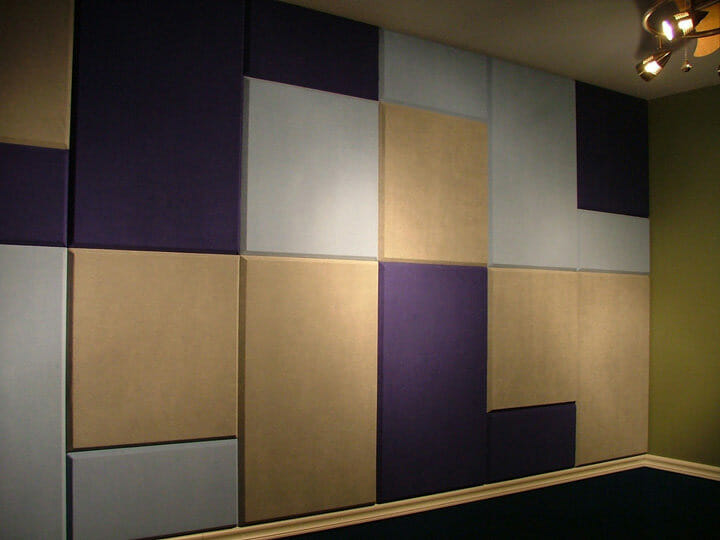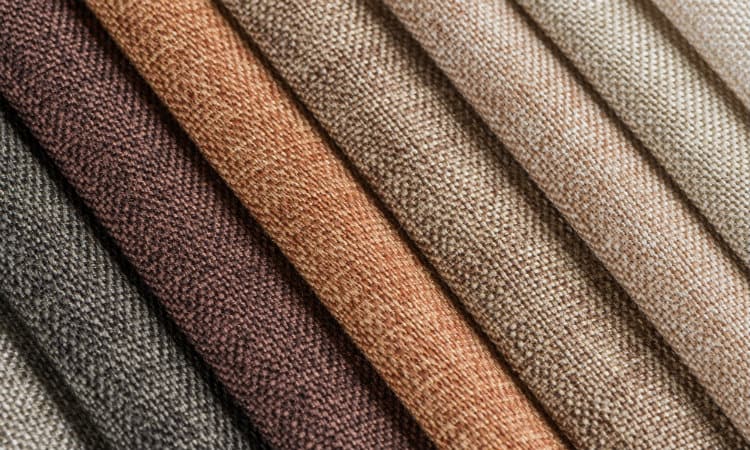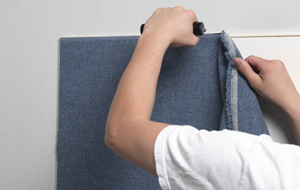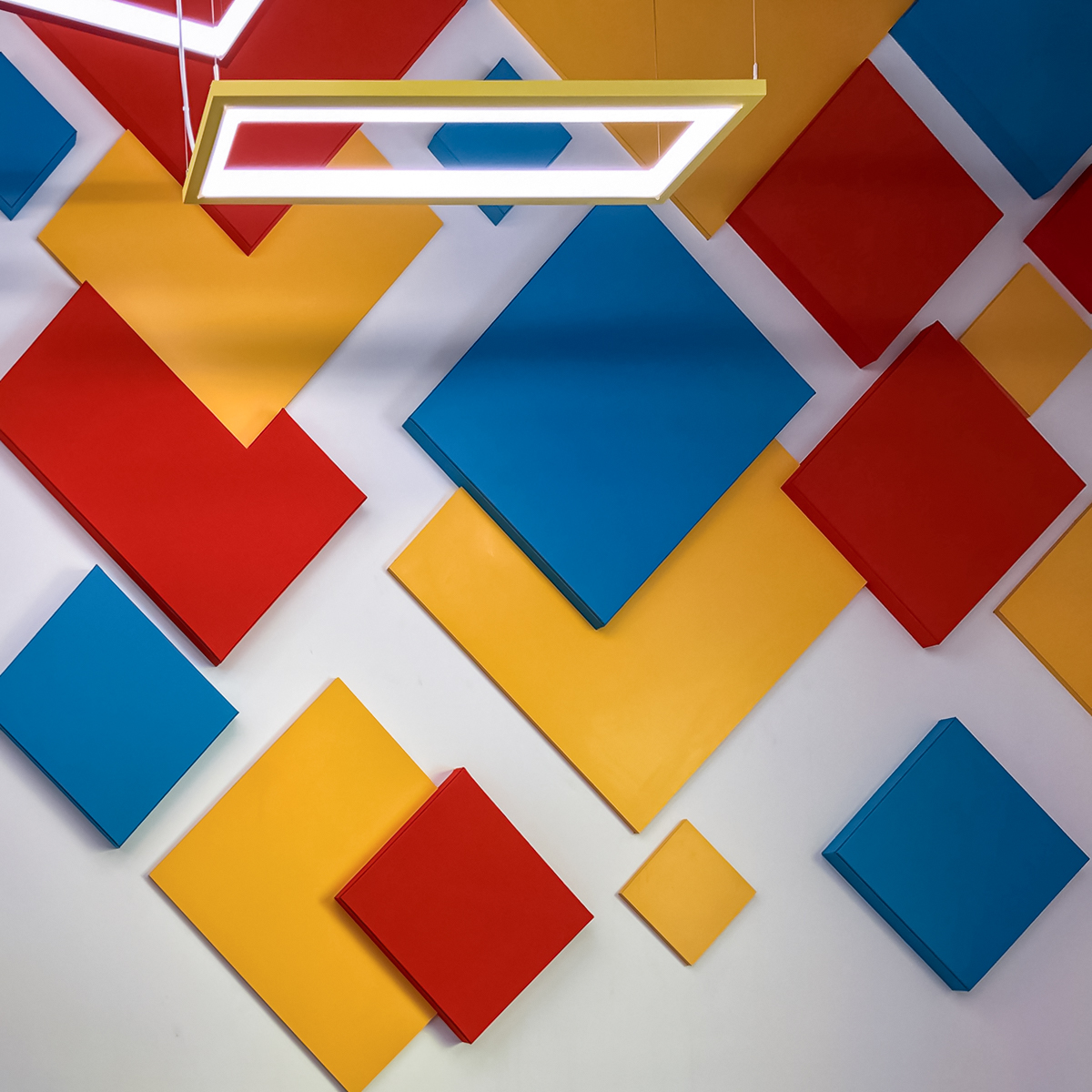 When it comes to acoustic wall panels, people always ask what the best fabrics to use are? In 2024, Choosing the right fabric to use for your application is crucial to ensure the effectiveness of acoustic panels.
When it comes to acoustic wall panels, people always ask what the best fabrics to use are? In 2024, Choosing the right fabric to use for your application is crucial to ensure the effectiveness of acoustic panels.
Some fabrics will perform better acoustically than others for several reasons, but to be honest, the fabric alone will not have a significant effect on sound absorption.
You need to select a suitable type of fabric and make sure it will work correctly with the other parts that make up the acoustic panels, such as the absorbing core. The most sound-absorbing part of any acoustic panel is the absorption core that the fabric covers or stretches over, is generally made of a semi-rigid type of acoustic foam or fiberglass.
The stretch fabric acoustical panels are an attractive face covering thallowslow the sound to travel through to the core material.
Here are some key points to remember when selecting the right type of fabric for sound-absorbing acoustic paneling.
 First, there are many textiles available on the market, the majority of which could be used as the front-facing covering of just about any acoustic panel.
First, there are many textiles available on the market, the majority of which could be used as the front-facing covering of just about any acoustic panel.
Some of these have been tested in a controlled environment and have data that shows how they perform as an ‘acoustic fabric.’ It would be impossible to test every type of fabric known to man, so we will take a look at some major key factors used in determining a good acoustic panel fabric.
1. Transparency / Breath-ability
This is most likely the most crucial factor. If you get this one wrong, then the absorption performance of your panels can be dramatically reduced.
Many fabrics available are either ‘backed ‘or ‘unbacked. ‘ They are lined with backed fabrics on one side with either acrylic or paper, normally to help with a wall application, much like applying wall coverings which are generally fabric or paper. Any fabric you decide to use with an acoustic paneling system should be ‘un-backed’ for two quite obvious reasons.
- Backed fabric helps prevent the majority of sound from transferring through them, and
- Backed fabrics do not stretch very well.
The fabric you select should have an open weave and is breathable; you can blow air through a sample of the fabric to see if it is breathable or not. Just make sure you don’t select one that has too much of an open weave; remember, you don’t want to see through the fabric to the core material. It is possible to purchase an acoustically transparent fabric and visibly evident, not what you want.
2. Functionality
Your fabric may be able to tick the boxes acoustically but will not have all of the properties that are conducive for an acoustic panel.
Below we will look at some of the different fabric types and reasons why you should avoid them.
In the case of stretched fabric panels, you don’t want any ripping or sagging to occur. This often happens in natural fiber materials such as cotton, wool, and linen, which can elongate in high humidity.
Material such as viscose and spun nylon will provide little stretch memory and might not return to its original tensity when exposed to humidity changes.
Fabrics such as acrylic and polyester are very stable and remain tight after stretching with no sagging risk. Synthetic materials are often seen as the most suitable for a stretched fabric system. But, as brilliant as the modern polyester fabrics are, many people love natural fibers, and therefore something like a blended fabric with over 50% polyester could be the best option.
3. Aesthetics
 These days, acoustic paneling has become more balanced between ‘aesthetics’ and ‘function.’ Designers and engineers are learning that solving many acoustic problems can be achieved in an aesthetically pleasing way. Now acoustic treatments are becoming the design focus of room interiors.
These days, acoustic paneling has become more balanced between ‘aesthetics’ and ‘function.’ Designers and engineers are learning that solving many acoustic problems can be achieved in an aesthetically pleasing way. Now acoustic treatments are becoming the design focus of room interiors.
We strongly believe using fabrics on ceilings and walls is an architectural design feature that will continue to evolve each year with the ever-growing focus on the benefits of good acoustics, more so in the IT-driven workplace.
What Fabrics Do Acoustic Wall Panels Manufacturers Use
A good indication of what fabrics work well acoustically is by looking at which ones are used by the manufacturers. Many acoustic manufacturers have a range of preferred fabrics that have been tested with their own systems.
In the UK, acoustic wall panel manufacturers tend to produce more pre-fabricated, affordable, wrapped panels. These open-weave fabrics, commonly used as upholstery for office seating and screens, are at the lower price end of the market.
European acoustic manufacturers typically use more expensive, higher-quality fabrics.
In the US, Whisper Walls has been the world’s most innovative provider of acoustic wall panels for interior noise control For over 30 years. From the beginning, we’ve been focused on providing products that blend a subtle fabric finish, acoustical performance, and long-lasting value. This unique objective inspired the development of specialized stretching system track components and installation tools that are now industry standards.
Acoustic wall panel systems are site-installed; they are highly customizable acoustic wall panels and ceiling systems that seamlessly integrate with any architectural design you may have. The system utilizes a proprietary designed custom track system that is stapled to the existing substrate. An absorbent or trackable core such as fiberglass is cut and stapled inside the track to hold it in place.
An acoustically transparent fabric is then cut and tightly tucked into all of the tracks surrounding the perimeter, providing you a perfect fit every time with no gaps or sagging. Acoustic wall panels offer architects complete design flexibility without sacrificing the quality of sound control.

How long do acoustic wall panels last?
The foam used in our acoustic wall panels is a chemically based product. So no matter the panel’s class A, the foam has an average shelf life of about seven years from the time the panels are produced. At that time, the foam most likely will start to flake off and sprinkle dust particles into the air.
What type of fabric is suitable for sound absorption?
Using a non-porous leather, vinyl, or acrylic-faced fabric will reflect much of the energy produced by the sound, reducing the effectiveness of your drapery.
You should select a fabric that could absorb water or has a plush, velour surface. If the price is a concern, then you might want to choose a less expensive fabric.
What type of foam is acoustic foam?
Acoustic foam is a lightweight polyurethane foam made from either polyether or polyester and also melamine foam.
What fabric is best for acoustic wall panels?
If the panels reflect any of the room’s sounds, then your panel is not performing the way it was designed.
For example, polyester and polypropylene work well on any vertical surface type, but a fabric made from nylon would not be right because it absorbs too much moisture.
Is canvas suitable for acoustic wall panels?
A canvas is a great way to add images to your walls, but, unfortunately, having a canvas on its own will not do much to block sound. If you’re looking for a soundproofing option with more of a personalized touch, then you will want to send your images to whisper walls and have them print them on the panel fabric so you can use it.
What material absorbs sound the best?
Normally a soft, pliable, or porous material will serve as a good acoustic insulator to absorb the most sound. Materials that are dense, hard, and impenetrable (such as any metals) will reflect the most sound.
How well a room absorbs sound is quantified by the walls’ effective absorption area, also called the total absorption area.
How can you tell if a fabric is acoustically transparent?
The most common way to test can be done by attempting to blow through the fabric. If air quickly passes through the material, it will also allow sound to pass through it, making that fabric acceptable for use as an acoustic fabric.
Do acoustic wall panels reduce noise?
Acoustic wall panels are composed of mineral wool or foam that has been compressed; sound-absorbing acoustic wall panels absorb the sound waves directed towards them to reduce noise, clarify speech, and reduce reverberation on the walls within an enclosed room.
A soundproofing panel is designed to block noise from entering or exiting a room.
What fabric is acoustically transparent?
An acoustically transparent fabric will allow sound to pass through it with a little barrier. This is an essential factor because you want the sound to pass through the fabric and be absorbed by the acoustic panels; for this, you will want to use an acoustic foam or fiberglass wool.
What are acoustic panels used for?
Acoustic panels are sound-absorbing panels designed to mitigate noise and reduce reverberation and any echo in the enclosed room. For both types, we look at the different principles of good acoustics: diffusion, absorption, and attenuation. These are all tied directly to the performance of the acoustic wall panels.
What type of insulation is used for acoustic wall panels?
There are two types of insulation commonly used for acoustic wall panels: fiberglass and mineral wool. Fiberglass insulation panels are made out of tiny inorganic glass fibers held together by a thermosetting resin binder and preformed into a rigid board with 2ft x 4ft rectangles.
Where do you put acoustic wall panels?
Most people will mount their acoustic wall panels flat on the walls throughout the entire room. To get the maximum effectiveness from a limited number of panels, try to avoid placing the panels on BOTH points of opposing walls; instead, stagger their positions.
Are acoustic panels necessary?
A home theater without any acoustic wall panels, you will experience sound waves reflecting from all surfaces of the room. Typically, you will want to hear only the sound coming directly from your speakers and not the sound reflected from walls, ceilings, and floors.
How thick should my acoustic wall panels be?
Acoustic wall panels will come in thicknesses of either 2″ or 4″. While traditional wisdom states that thicker is better, 2″ panels are considered the industry standard by many. They will not be able to absorb frequencies as low as 4″ panels, but that’s OK.
So as you can see, there is a huge difference between normal glue or staple-down fabric and acoustic wall panels, yes, there is a cost difference but there is also a quality difference.
 Whisper Walls
Whisper Walls